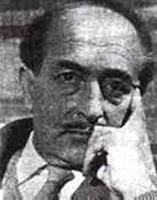| 出生地: | 西西裏島的錫臘庫札 | ||||
閱讀薩瓦多爾·誇西莫多 Salvatore Quasimodo在诗海的作品!!! | |||||
意大利詩人。生於西西裏島的文化古城錫臘庫札,父親是一個小車站的站長。1916年考入西西裏首府巴勒莫技術學校,1919年進入羅馬工學院學士木建築。由於家庭經濟睏難,中斷學習,當過繪圖員、營業員等。1926年,被分配到勞工部卡拉布裏亞大區土木工程局,擔任測繪員。1931年轉入米蘭土木工程局。1938年離開建築工程部門,擔任著名作傢、電影編劇柴伐蒂尼的秘書。隨後,進入《時報》編輯部任文學編輯。1939年,由於從事反法西斯活動,被解聘並遭到官方刊物的攻訐。1941年,由於從事反法西斯活動,被聘任為米蘭威爾等音樂學院意大利文學教授。1948至1964年,先後在《火車頭》、《時報》、《小時》等報刊編輯部主持專欄。1968年6月,因腦溢血突發而逝世。
誇西莫多與蒙塔萊、翁加雷蒂並稱為當代意大利最傑出的詩人,是“隱逸派”詩歌的重要代表。早在1916年就開始發表抒情詩。1930年,第一部詩集《水與土》的問世,使他一舉成名。此後,他陸續發表了詩集《消逝的笛音》(1932)、《厄拉托與阿波羅》(1936)、《瞬息間是夜晚》(1941)。這一時期的詩作鮮明地體現了隱逸派詩歌的特徵。詩人對童年的追憶,對故鄉西西裏的懷念,對母親和戀人的情思,無不以富於古典美的和諧韻律和微妙而明晰的意象訴之於詩。
反法西斯抵抗運動使誇西莫多的詩歌創作進入了一個新的境界。自此,他的抒情詩註入了“社會詩”的內涵。個人的憂鬱和感喟化為對整個社會和人類命運的深沉思索和對黑暗勢力的鞭笞。這一時期,最出色的詩歌結集為《日復一日》(1947)。隨後,相繼出版的詩集是《生活不是夢》(1949)、《假緑與真緑》(1956)、《樂土》(1958)、《墨汁中的米蘭》(1963)和《給予和獲得》(1965)等。
誇西莫多精通意大利古典文學和外國文學,他的翻譯和研究都發生過廣泛的影響。此外,他還著有文藝評論多捲。
1959年,由於“他的抒情詩以高貴的熱情表現了我們時代生活中的悲劇”,獲得諾貝爾文學奬。
Biography
Quasimodo was born in Modica, Sicily. In 1908 his family moved to Messina, as his father had been sent there to help the population struck by a devastating earthquake. The impressions of the effects of natural forces would have a great impact on the young Quasimodo. In 1919 he graduated in the local Technical College. In Messina he also made friends with Giorgio La Pira, future mayor of Florence.
In 1917 Quasimodo founded the short-lived Nuovo giornale letterario ("New Literary Journal"), in which he published his first poems. In 1919 he moved to Rome to finish his engineering studies, but poor economical conditions forced him to find a work as technical drawer. In the meantime he collaborated with several reviews and studied Greek and Latin.
In 1929, invited by Elio Vittorini, who had married Quasimodo's sister, he moved to Florence. Here he met poets such as Alessandro Bonsanti and Eugenio Montale. In 1930 he was received from Italy's Civil Engineering Corps a job in Reggio Calabria. Here he met the Misefari brothers, who encouraged him to continue writing. Developing his nearness to the hermetism movement, Quasimodo published his first collection, Acque e terre ("Waters and Earths") in that year.
In 1931 he was transferred to Imperia and then to Genoa, where he got acquainted with Camillo Sbarbaro and other personalities of the Circoli magazine, with which Quasimodo started a prolific collaboration. In 1932 he published with them a new collection, Oboe sommerso, including all his lyrics from 1930-1932.
In 1934 Quasimodo moved to Milan. Starting from 1938 he devoted himself entirely to writing, working with Cesare Zavattini and for Letteratura, official review of the Hermetic movement. In 1938 he published Poesie, followed the translations of Lirici Greci ("Greek Poets") in 1939.
Though an outspoken anti-Fascist, during World War II Quasimodo did not take part in the Italian resistance against the German occupation. In that period he devoted himself to the translation of the Gospel of John, of some Catullus's cantos and several episodes of the Odyssey. In 1945 he became a member of the Italian Communist Party.
In 1946 he published another collection, Giorno dopo giorno ("Day After Day"), which made clear the increasing moral engagement and the epic tone of social criticism of the author: the same line characterized his next works, La vita non è sogno ("Life Is Not a Dream"), Il falso e il vero verde ("The False and True Green") and La terra impareggiabile ("The Incomparable Land"). In all this period Quasimodo did not stop producing translations of classic authors and collaborating as a journalist for some of the most prestigious Italian publishings (mostly with articles about theatre).
In the 1950s Quasimodo won the following awards: Premio San Babila (1950), Premio Etna-Taormina (1953), Premio Viareggio (1958) and, finally, the Nobel Prize for Literature (1959). In 1960 and 1967 he received honoris causa degrees from the Universities of Messina and Oxford, respectively.
In his last years the poet made numerous voyages in Europe and America, holding public speeches and public lectures of his poems, which had been translated in several foreign countries.
In June 1968, when he was in Amalfi for a discourse, Quasimodo was struck by a cerebral hemorrhage. He died a few days later in the Hospital of Naples. He was interred in the Cimitero Monumentale in Milan.
Poetical Language
Traditional literary critique divides Quasimodo's work into 2 major periods: the hermetic period up until World War II, and the post-hermetic era until his death. Although these periods are distinct, they are to be seen as a single poetical quest. This quest or exploration for a unique language will take him through various stages and various modalities of expression.
As a young poet, Quasimodo uses a hermetical, "closed" language to sketch recurring motives like Sicily, Religion and Death. Subsequently, the translation of authors from Roman and Greek Antiquity enables him to extend his linguistic toolery. The disgust and sense of absurdity of WW II will also have its impact on the poet's language. This bitterness, however, will fade in the late writings, and will be replaced by the mature voice of an old poet that reflects upon his world.
Opere
Acque e terre (1930)
Oboe sommerso (1932)
Erato e Apòllìon (1938)
Poesie (1938)
Lirici Greci (1940)
Ed è subito sera (1942)
Con il piede straniero sopra il cuore (1946)
Giorno dopo giorno (1947)
La vita non è sogno (1949)
Il falso e vero verde (1954)
Il fiore delle "Georgiche" (1957)
La terra impareggiabile
Il poeta e il politico e altri saggi (1960)
Dare e avere (1966)
